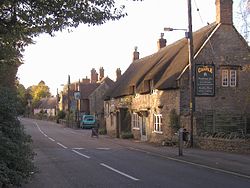West Coker
| West Coker | |
| Somerset | |
|---|---|
 High Street, West Coker | |
| Location | |
| Grid reference: | ST515135 |
| Location: | 50°55’8"N, 2°41’29"W |
| Data | |
| Population: | 2,828 (2011[1]) |
| Post town: | Yeovil |
| Postcode: | BA22 |
| Dialling code: | 01935 |
| Local Government | |
| Council: | South Somerset |
| Parliamentary constituency: |
Yeovil |
West Coker is a large village and parish in Somerset, situated three miles south-west of Yeovil.
History
The name Coker comes from Coker Water ("crooked stream" from the Celtic Kukro).[2]
Artefacts from early settlement in the parish include a polished stone axe and boat shaped-bronze broach. A Roman villa has been excavated and a bronze plate inscribed to the god Mars discovered.[2] From this Mars was given the title Mars Rigisamus (which means "greatest king" or "king of kings") as it depicts a standing naked male figure with a close-fitting helmet; his right hand may have once held a weapon, and he probably originally also had a shield (both are now lost). The same epithet for a god is recorded from Bourges in Gaul. The use of this epithet implies that Mars had an extremely high status, over and above his warrior function.
The manor descended with its neighbour East Coker until the 14th century when it passed to a junior branch of the Courtenay family. It was later held by the Dukes of Somerset Northumberland protectors of Edward VI and later still by the Portmans of Orchard Portman.[2]
The original manor house burned down during an attack in the Wars of the Roses,[2] although the current hamstone manor house has mediæval origins, the earliest surviving portions probably being of around 1500. It is a Grade-I listed building.[3]
The village had a long history of growing hemp and flax for sailcloth manufacture, which made "Coker Canvas" highly prized by naval captains during the Napoleonic Wars.[2] Dawes Twine Works, a late 19th-century[4] historic building in the village used for the manufacture of rope and twine, was a featured candidate on the BBC Restoration TV series in 2006. The ropewalk is on the Heritage at Risk register.[5]
Geography
Nearby is the Hardington Moor Site of Special Scientific Interest and national nature reserve where meadows are examples of species-rich unimproved neutral grassland, which is now nationally rare. The rare French oat-grass is very abundant on the site and the fields are home to a wide variety of plant species, most notably adder's tongue, corky-fruited water-dropwort and large numbers of green-winged orchid. Invertebrates found at the site include butterflies such as gatekeeper, small tortoiseshell and common blue. Less commonly seen are large skipper, green-veined white and green hairstreak.[6]
Village features and services
West Coker is served by three pubs — the Royal George, the Inn in the Square (formerly known as Skittles) and the Castle. Near the village centre there is a garage (which incorporates a local shop), a butcher's shop, a post office, Lanes Hotel/restaurant and a bistro. About one mile to the east are the Yeovil Court hotel and a petrol station and convenience store. There are other small businesses on the site of a former twine works in East Street. West Coker Primary school has about 80 pupils. The West Coker Commemoration Fund is a charity which administers the affairs of the village hall.
Religious sites
The Church of Saint Martin of Tours has 13th- or 14th-century origins but was mostly rebuilt in 1863-64.[7] Within the church is a quarter of the carpet used at the Coronation of Queen Elizabeth II.[8]
Notable residents
- Lieutenant-Colonel Sir Matthew Nathan, GCMG (1862–1939) a British soldier and civil servant, who variously served as the Governor of Sierra Leone, Gold Coast, Hong Kong, Natal and Queensland, died in the village.
References
- ↑ "Statistics for Wards, LSOAs and Parishes — SUMMARY Profiles" (Excel). Somerset Intelligence. http://www.somersetintelligence.org.uk/files/Somerset%20Census%20Key%20Statistics%20-%20Summary%20Profiles.xls. Retrieved 4 January 2014.
- ↑ 2.0 2.1 2.2 2.3 2.4 Bush, Robin (1994). Somerset: The Complete Guide. Dovecote Press. pp. 227–228. ISBN 1-874336-26-1.
- ↑ "Manor House". Images of England. English Heritage. http://www.imagesofengland.org.uk/Details/Default.aspx?id=263875. Retrieved 2008-10-05.
- ↑ "The Former Ropewalk, 75 Metres North East of Millbrook House". Images of England. English Heritage. http://www.imagesofengland.org.uk/Details/Default.aspx?id=263870. Retrieved 2008-10-05.
- ↑ "The former Ropewalk, 75 metres north east of Millbrook House, High Street, West Coker — South Somerset". Heritage at Risk. English Heritage. http://risk.english-heritage.org.uk/register.aspx?id=48511. Retrieved 19 October 2013.
- ↑ Hardington Moor NNR
- ↑ "Church of Saint Martin of Tours". Images of England. English Heritage. http://www.imagesofengland.org.uk/Details/Default.aspx?id=263796. Retrieved 2008-10-05.
- ↑ Byford, Enid (1987). Somerset Curiosities. Dovecote Press. p. 83. ISBN 0946159483.
Further reading
- Shorey, David, and Dodge, Michael and Nadine (2008). Book of West Coker: a pictorial and social history of a Somerset village, Wellington, Somerset: Halsgrove Publishing, ISBN 1-84114-799-0
Outside links
| ("Wikimedia Commons" has material about West Coker) |